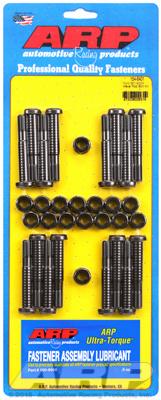Rod Bolt Kit SB Ford 351-400M Wave-loc
Unquestionably the most important fasteners in any engine are the connecting rod bolts, as they hold the key to the entire rotating assembly. A broken bolt will lead to catastrophic engine failure. As you can imagine, the most critical joint is where the connecting rod halves mate.
Unquestionably the most important fasteners in any engine are the connecting rod bolts, as they hold the key to the entire rotating assembly. A broken bolt will lead to catastrophic engine failure. As you can imagine, the most critical joint is where the connecting rod halves mate. The rod bolts must support the primary tension loads caused by each rotation (or cycle) of the crankshaft. When the crank rotates, the big end of the connecting rod essentially becomes oval-shaped and the rod bolts bend. As the crankshaft continues to rotate, the rod becomes round again. With alternating tension loads and cyclic bending of the bolts, it is very important to install fasteners that are able to exert a clamping force greater than the load imposed upon the joint (tension).
In addition to utilizing a rod bolt with sufficient strength to withstand the tremendous cyclical strains placed upon it, it is absolutely imperative that the bolts be properly tightened. The preferred method of monitoring the correct amount of tension is through use of a stretch gauge. This is far more accurate than using a torque wrench. Moreover, through subsequently checking the rod bolts length at teardowns, it is possible to determine if it has been stressed beyond safe limits and must be replaced.
The same heat-treated 8740 chrome moly steel is used to make these rod bolts as ARP's standard High Performance rod bolts. The big difference is in the shank design, with ARP's exclusive (and patented) Wave-Loc technology providing substantial benefits. Because there are fairly wide tolerances in factory bolt holes, the bolt must be able to fit snugly and a knurl is applied. Unfortunately, these knurls cut deep into the bolt material, leaving sharp edges and enormous "stress risers" that promote failure. That's why ARP developed the Wave-Loc design that features symmetrical waves and has an effective interference range of .001" to .005" for proper cap alignment.
